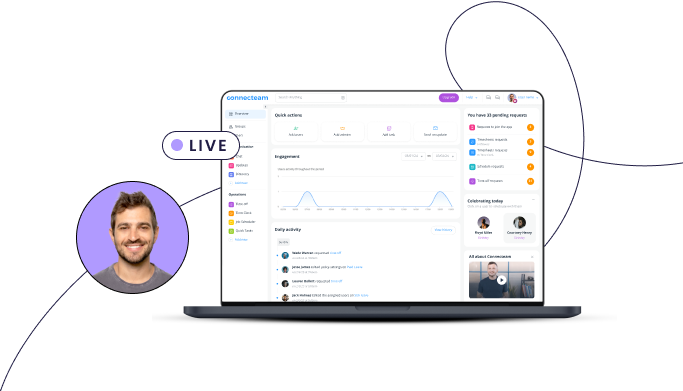Writing a PTO request email is a professional way to request company vacation time. In this guide, we review how to write a PTO-request email and include some examples.
Imagine you want to go on vacation with your family, take a weekend trip with your partner, or even just take a few days off for a bit of rest and relaxation. How do you effectively ask your manager to take some company vacation?
You could ask them in person, but they’re likely busy in meetings, and you may not get a fast response. You could text them, but that feels too casual for the workplace. Sending a paid-time-off (PTO) request email strikes a good balance between professionalism and getting a speedy response.
This article discusses what a PTO-request email is. It will also show you how you can request vacation time via email and our top tips for writing the best time-off request possible.
The Watercooler EP 03: How to Write a PTO Request Email
Jessica and Tod chat about how to write a clear and professional PTO request email. Tune in to get practical advice on crafting the perfect message to request time off.
What Is a PTO Request Email?
A PTO request email is an email you send to your manager to request paid time off from work. It’s a formal and professional way to submit a paid time-off request to your manager.
What is PTO?
PTO is a benefit where employees are paid for the time they aren’t working. While it is not a legal requirement for your employer to offer PTO as a benefit, it can contribute to a strong company culture and help you balance work and home life.
Even if your workplace doesn’t offer PTO, the advice and examples included in this article will help you write a strong email to request any type of time off.

Why is PTO Important?
PTO can help you to strike a healthy work-life balance and has many benefits for your well-being and happiness.
A study from SHRM found that employees cite paid time off as the second most important benefit in the workplace. This study also found that employees who are encouraged to take their PTO are 68% happier overall than those who aren’t.
In addition, Forbes found that employee burnout is one of the leading causes of employee turnover in the workplace. Almost 50% of employees stated burnout was the reason for leaving their jobs in 2019. Making sure you take regular breaks can help prevent you from reaching the point of burnout. It can also help you to maintain a healthy work-life balance.
Pro Tip
Unsure of how to establish a PTO policy that fits your business? Check out our article on how to create a PTO program for tips and strategies on how to do it right.
How to Write a PTO Request Email
To ensure your PTO-email request has the best chance of being approved, we’ve provided some steps for you to follow.
Step 1: Consider whether a PTO-request email is necessary
While a PTO request email is a great way to ask for vacation days, there are more straightforward ways to request time off. It is also a good idea to check your company’s employee handbook to see how your company would like you to request PTO.
Did You Know?
Dedicated PTO software makes requesting and tracking PTO much easier for employees and managers.
Connecteam’s easy-to-use employee PTO tracker is the perfect tool to help you request and manage your PTO. Instead of the slow email process, employees can request PTO with just a few taps on their phones, while managers receive notifications for each request and can quickly approve or deny them.
Get started with Connecteam for free today!
Try the #1 Tool for Managing Time Off!
Learn how Connecteam ensures all your PTO requests are approved and logged properly so you always know when your next vacation is.
Step 2: Write a clear email subject line
Once you’ve determined that an email is the best course of action, the first step to writing a PTO-request email is to write a clear subject line. This lets your manager know what you’re asking for before they open the email and supports them in managing their workload effectively. Include a short description of the email content in the subject line, such as “Your Name—PTO Request.” This is a clear and professional subject line.
Writing a clear subject line for your email can also help your manager if they’re searching for the email at a later date.
Step 3: Start with informalities.
Once you’ve completed your subject line, it’s time to write an email to your manager. It is a good idea to start the body of the email with an informal tone. Greet your manager in an appropriate way, for example:
“Hi, [manager’s name]
I hope you’re well today.”
OR
“Good morning, [manager’s name]
How was your weekend?”
Both options are friendly and professional and are the perfect precursor to requesting vacation time.
Step 4: State your required days
After these informalities, turn your attention to the matter at hand. Begin by stating that you are requesting PTO. Be clear about dates and highlight that you are giving advance notice. Try this format:
“I would like to use X days of my company-allocated PTO days. I am requesting [MM/DD/YYYY – MM/DD/YYYY] to be used as PTO. Please note that I am giving [X] full weeks of advanced notice to take these dates.”
Clearly stating which days you would like off will eliminate confusion, make it easy for your manager to determine if they can allow it, and help them calculate your PTO accrual if they need to do so manually.
Step 5: State your reasons for the absence
While it’s not a requirement to state the reasons for your request, it can help your manager to understand how important the time off is to you. This might make them more likely to approve the time off.
You don’t have to share every detail about why you want the time off. But telling them how you’re excited to take a vacation with your family or how much you need a few days to yourself might help them understand why the PTO is important to you.
Pro Tip
Once you approve an employee’s PTO request, make sure to document it immediately. Whether you use Excel to track vacation requests or a time management app like Connecteam, inputting time off requests right away will prevent you from accidentally scheduling a worker while they’re away.
Get started with Connecteam for free today!
Step 6: Prepare in advance
Provide evidence in the email for how you’ve prepared for the time off in advance and assure your manager that your work will be completed before you leave. For example:
“My current tasks will be completed before I go on vacation, and I have already asked [colleague’s name] to pick up my duties while I am off. I will also be contactable for emergencies only via [phone number/ email].”
Step 7: Request permission
Finish off the email by asking politely for your manager’s permission.
“Let me know if this request works with your schedule” OR “Will this be acceptable?”
Step 8: Thank your manager and sign off
Thank your manager for considering your request and sign off your email in a friendly and professional way.
“Thanks for considering my request. I look forward to hearing from you.
Kind regards,
[Your name]”

Leave Request Email Examples and Top Tips
Remember, requesting PTO is not a guarantee that it will be granted. Follow our tips and examples below to build the strongest case possible so your PTO request gets approved.
Example 1: Formal vacation request email
In this example, an employee—Susanne Connors—is emailing her manager—Joan Jenkins—to request some time off. Susanne wants to take a weekend trip to the fairground with her partner Jenny. Susanne has over three weeks of accrued PTO to take and has already organized for her colleague—Tim—to cover her calls while she is away.
Formal requests are more common in corporate or public sector environments. If the tone of your emails is usually formal, consider adopting the same approach when writing a PTO request.
Subject line: Susanne Connors—PTO request
Dear Joan,
I hope you are well today.
Top Tip: In formal environments, using professional greetings is recommended. You could also try “I trust this email finds you well” for corporate environments.
I would like to take two days of my company-allocated vacation time. I’m making this request for Thursday, the 20th of April, and Friday, the 21st of April, 2023. Please note that I am giving over three months of notice for this PTO request.
I plan to book a weekend trip for myself and my partner—Jenny—to visit a fairground. Jenny’s grandma used to take her to the same fairground when she was a little girl, and I wanted to surprise her by taking her to the same one.
Top Tip: Share something specific you’re looking forward to about your trip, or ask for a recommendation if you know it’s somewhere your manager has been. Finding common ground makes them more likely to say yes!
I have already asked Tim to cover my calls and messages while I am away, and I will be available via phone and email for emergencies.
Let me know if this request works with your schedule. I look forward to hearing from you.
Kind regards,
Susanne
Example 2: Informal vacation request email
In this example, an employee—Marco—is emailing his manager—Aiden—to request two weeks of PTO. Marco works as part of a team, and his colleague—Amy—has agreed to answer Marco’s emails while he is away. Marco’s company has an unlimited PTO model and a less formal organizational culture.
Because of this informal organizational culture, Marco has a more conversational style with his manager. If you work in a start-up or small organization, it might be better to adopt this approach.
Subject line: Marco—Vacation Request
Hi Aiden,
How was your weekend? I heard you visited the beach with your kids.
I plan to take some PTO between 02/06/23 and 02/12/23 to travel to San Diego. I remember you told me about a bar near there—What was the name again? I might check it out!
I hope that six weeks is enough notice to take some time off work, but I’m happy to reschedule the dates if they don’t work for the team.
Top Tip: In this example, Marco is happy to be flexible about his travel dates to support the team. If you can offer flexibility, highlight this in your email—It shows you’re a team player!
Amy has said she’s happy to pick up any unanswered emails while I’m away. If you need me, I’ll still be available on IM. Hopefully, my timezone will update properly!
Top Tip: In an informal PTO request email, try including a joke or a holiday emoji to show excitement. However, this should be avoided in formal emails.
Let me know your thoughts and any recommendations you have for visiting Spain! I know you’ve visited a few times.
Thanks again,
Marco
Top Tip: Once you have requested your PTO, set an appointment in your calendar for a week’s time. If you haven’t heard back from your manager by then, send a reminder email to see whether any issues are preventing you from booking those vacation dates.
Another thing I like about Connecteam is how easy it is to request time off. Instead of having to contact the staffing department directly, I’m able to go into the app and put in the request.
Conclusion
PTO is a great way to take some time off work without suffering any financial loss. There are great benefits to taking any PTO you might be offered. These include helping you find a better work-life balance and boosting your productivity.
However, your work must not suffer in your absence. To prevent this, make sure you let your manager know what time you intend to take off by sending them a PTO request email. Be clear about which dates you’re requesting off, and let them know what you’ll get up to in that time.
You can also request PTO through software like Connecteam. Sign up for a free trial to find out more about using Connecteam in your workplace.
The #1 Employee Management App
Keep your team on track by managing time off and sick days with Connecteam. Try it for free today. No credit card required.





